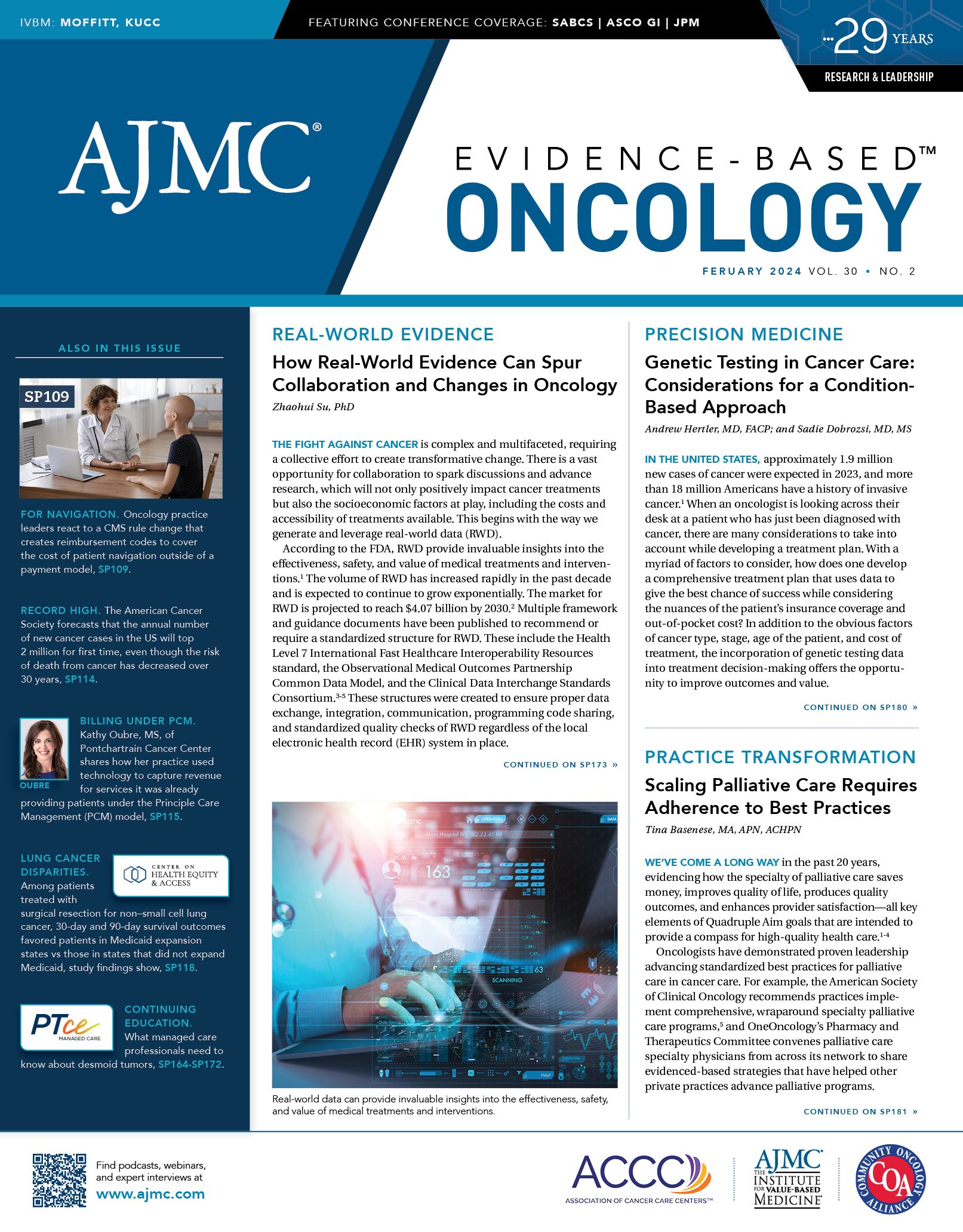- Center on Health Equity & Access
- Clinical
- Health Care Cost
- Health Care Delivery
- Insurance
- Policy
- Technology
- Value-Based Care
Hypofractionated Chemoradiation Regimen With an Adaptive SABR Boost Shows Promise in NSCLC
An early-phase, dose-escalation study of a hypofractionated approach to concurrent chemoradiation using an an adaptive stereotactic ablative radiotherapy (SABR) boost showed promising results in patients with locally advanced, unresectable non–small cell lung cancer (NSCLC).
Hypofractionated concurrent chemoradiation (cCRT) at doses higher than usual followed by an adaptive stereotactic ablative radiotherapy (SABR) boost showed promising safety and efficacy in patients with locally advanced, unresectable non–small cell lung cancer (NSCLC), according to a study published in JAMA Oncology.1
Outcomes in NSCLC have improved in recent years with the advent of modern treatments such as immunotherapy, but disease relapse in the chest remains the predominant pattern of progression following standard-of-care concurrent chemoradiation followed by immune checkpoint inhibitor consolidation therapy, the study authors explained. While dose-escalated conventional fractionation has been explored in previous studies, results have been poor, and the standard total dose has remained at 60 Gy, with 1.8 to 2 Gy delivered per fraction.
SABR entails a hypofractionated approach, delivering precise and high-dose radiotherapy in fewer fractions, and the strategy has already shown promise in early-stage NSCLC.2 With this approach, treatment is completed on a shorter timeline and fewer visits, which may improve the patient experience if feasible.
Lungs | Image credit: Crystal light - stock.adobe.com

“This treatment method explores uncharted territory,” Trudy Wu, MD, a radiation oncology resident at UCLA and first author of the study, said in a statement.3 “Our field has been moving towards hypofractionation across many disease sites; however, it is particularly challenging in locally advanced lung cancer due to the close vicinity of tumor to sensitive structures such as the airways and esophagus. This treatment is also typically delivered with chemotherapy which magnifies treatment-related toxicity. Using a novel adaptive boost technique personalized to an individual’s treatment response after the first two thirds of radiation treatment allows for a tighter conformal radiation boost plan and reduction of healthy tissue receiving radiation.”
The early-phase, nonrandomized, controlled radiation dose-escalation study aimed to determine the maximum tolerated dose (MTD) of definitive hypofractionated cCRT with an adaptive SABR boost (HyCRT-SABR).1 Between May 2011 and May 2018, a total of 28 patients with NSCLC were enrolled and treated, with 10 receiving low-dose therapy, 9 receiving an intermediate dose, and 9 receiving high-dose therapy. Most patients (86%) had unresectable stage III NSCLC.
All patients first received a dose of 4 Gy for 10 fractions, then an adaptive SABR boost targeting any residual and metabolically active disease based on F-fludeoxyglucose–positron emission tomography (FDG-PET) and CT scans conducted following the first 8 or 9 fractions. Additional doses of 25 Gy in (5 Gy for 5 fractions), 30 Gy (6 Gy for 5 fractions), or 35 Gy (7 Gy for 5 fractions) were given in the low-dose, intermediate-dose, and high-dose cohorts, respectively, based on the FDG-PET and CT restaging.
All patients except 1 in the low-dose cohort received concurrent chemotherapy, but all patients completed the cCRT protocol and interim staging as planned. Consolidation carboplatin/paclitaxel was given to 6 patients and 1 patient received durvalumab, while the rest did not receive consolidation immunotherapy. In the overall cohort, the median follow-up was 18.2 (1.8-99.7) months.
Overall, the incidence of acute nonhematologic grade 3 or higher toxic effects was 11%, and the incidence of late nonhematologic grade 3 or higher toxicities was 7%, but no grade 3 toxic acute or late effects were seen among patients treated with an intermediate dose. Most patients overall (89%) experienced acute grade 1 or 2 toxic effects, however.
While there were no statistically significant differences between the 3 cohorts in terms of toxic effect incidences, most grade 3 or higher toxic events were seen in the high-dose cohort. Two treatment-related deaths occurred in the high-dose cohort due to pulmonary toxic effects.
The MTD was not reached in the study, as all 3 dose-escalation groups underwent treatment as planned with minimal dose-limiting toxic effects.
The rate of local disease control at 2 years was 74.1% in the low-dose cohort, 85.7% in the intermediate-dose cohort, and 100.0% in the high-dose cohort. Overall survival (OS) in each respective cohort was 30.0%, 76.2%, and 55.6%, suggesting OS was improved in the intermediate- and high-dose cohorts vs the low-dose cohort. Median OS among all patients in the study was 25.9 months, with pooled OS rates of 78.6% and 52.5% at 1 and 2 years, respectively.
The study was limited by its nonrandomized design, small sample size, and limited follow-up. The authors also noted that there were fewer patients with stage III disease, as well as lower initial internal target volumes in the intermediate cohort, although a statistically significant difference between cohorts in this regard was not seen.
Overall, the authors concluded that the study exceeded previous attempts at dose escalation and mitigated toxic effects via the metabolic-based adaptive SABR boost strategy, with 2-year local control rates superior to historical standards. The 4 Gy or higher per fraction dose protocol with concurrent chemotherapy also showed acceptable safety, they added. Finally, they noted that treatment-related deaths occurred despite using advanced imaging and planning, the adaptive SABR boost technique, and adherence to dosimetric criteria, cautioning against the biologic effective dose equivalent of 70 Gy in 15 fractions in future research.
With the most promising HyCRT-SABR results seen in the intermediate-dose cohort, which received 70 Gy in 15 fractions with an adaptive SABR boost and concurrent platinum-based chemotherapy, the findings suggest potential for excellent local control without severe acute or late toxic effects using this strategy and support further research in this area.
"The authors should be commended for conducting such an ambitious dose-escalation trial, especially in the context of concurrent chemotherapy," wrote the authors of an invited commentary also published in JAMA Oncology.4 "By incorporating offline adaptive imaging and modern treatment planning and delivery, they took a thoughtful approach to using technological advances to push the limits of dose escalation for patients with stage III disease who have not yet benefited from such approaches."
References
1. Wu TC, Luterstein E, Neilsen BK, et al. Accelerated hypofractionated chemoradiation followed by stereotactic ablative radiotherapy boost for locally advanced, unresectable non–small cell lung cancer: a nonrandomized controlled trial. JAMA Oncol. Published online January 11, 2024. doi:10.1001/jamaoncol.2023.6033
2. Timmerman RD, Hu C, Michalski J, et al. Long-term results of RTOG 0236: a phase II trial of stereotactic body radiation therapy (SBRT) in the treatment of patients with medically inoperable stage I non-small cell lung cancer. Int J Radiat Oncol Biol Phys. 2014;90(1)(suppl):S30. doi:10.1016/j.ijrobp.2014.05.135
3. High-dose radiotherapy with chemotherapy effective in treating people with non-small cell lung cancer. News release. UCLA Health. January 11, 2024. Accessed January 12, 2024. https://www.uclahealth.org/news/high-dose-radiotherapy-with-chemotherapy-effective-treating
4. Lester-Coll NH, Park HS. Stereotactic body radiotherapy in locally advanced non–small cell lung cancer—is this the future? JAMA Oncol. Published online January 11, 2024. doi:10.1001/jamaoncol.2023.5856

Integrated Care for Chronic Conditions: A Randomized Care Management Trial
December 3rd 2025The authors sought to understand the differential impact of payer-led community-based care management approaches on stakeholder-oriented outcomes for publicly insured adults with multiple chronic conditions.
Read More
